Leadership Report: Traits, Styles, Scenarios, and Personal Profile
VerifiedAdded on 2020/11/23
|9
|2514
|188
Report
AI Summary
This report provides a comprehensive analysis of leadership, exploring various styles and traits essential for effective management. It begins by identifying key leadership traits from trait theory, such as drive, self-confidence, honesty, and integrity, and contrasting them with traits that may not align with the theory. The report then delves into situational, transformational, and servant leadership styles, evaluating their effectiveness and reflecting on personal experiences within an HR management context. A significant portion of the report is dedicated to analyzing leadership scenarios using models like the Hershey-Blanchard and Path-Goal, offering insights into how different leadership styles can be applied to various situations. Finally, the report culminates in the creation of a personal leadership profile, identifying key accomplishments, areas for development, and development activities aimed at enhancing leadership capabilities, such as improving problem-solving and interpersonal skills.
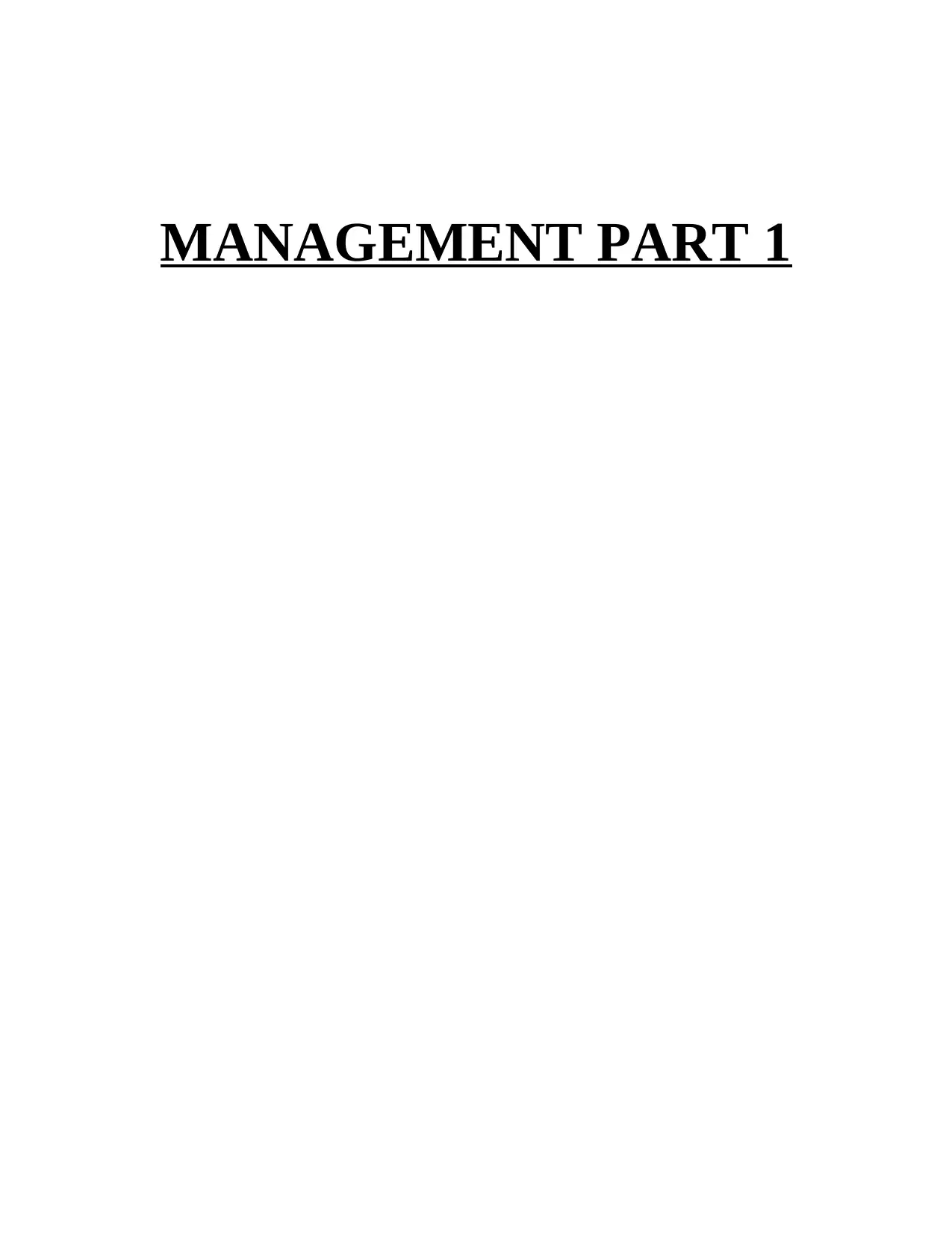
MANAGEMENT PART 1
Paraphrase This Document
Need a fresh take? Get an instant paraphrase of this document with our AI Paraphraser
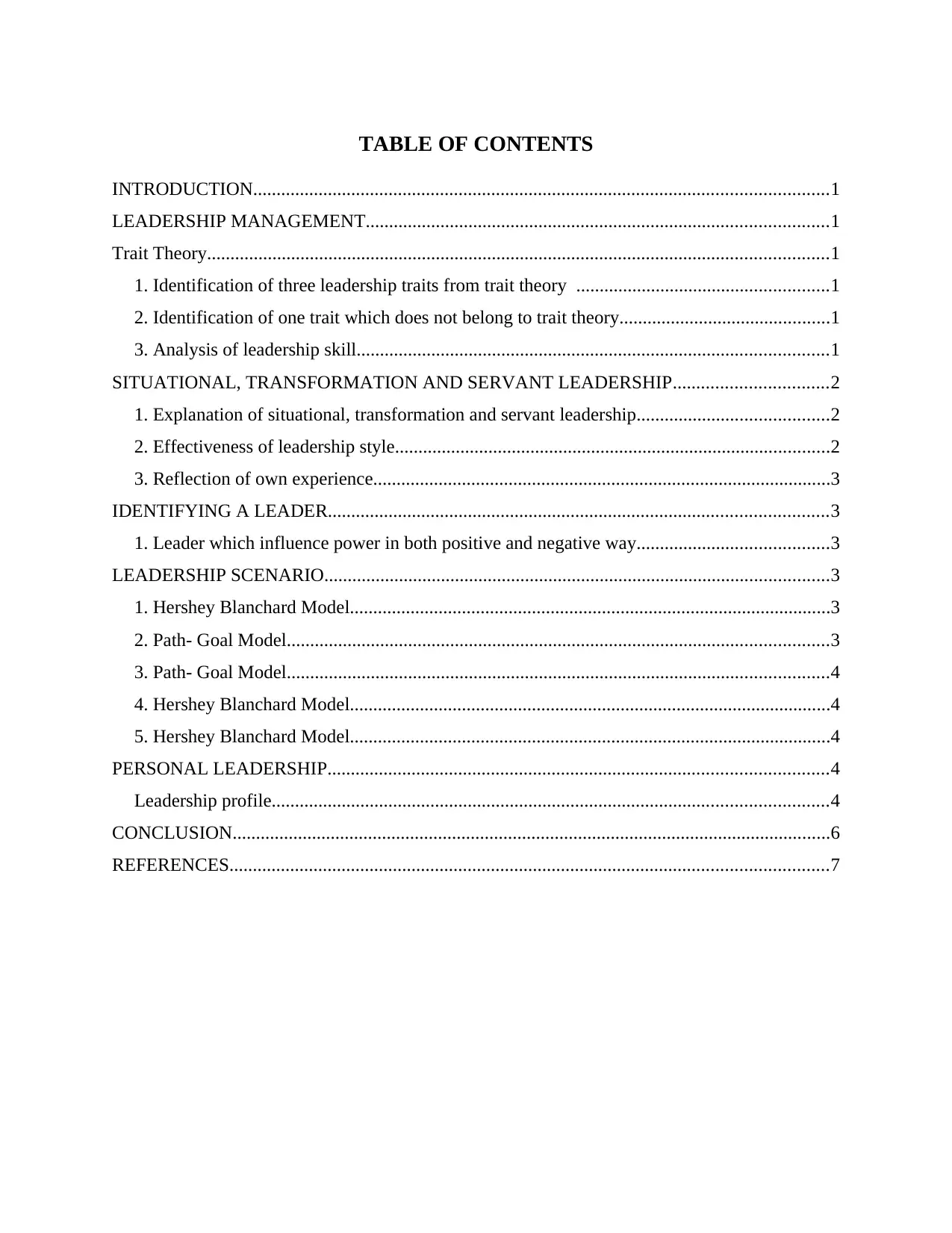
TABLE OF CONTENTS
INTRODUCTION...........................................................................................................................1
LEADERSHIP MANAGEMENT...................................................................................................1
Trait Theory.....................................................................................................................................1
1. Identification of three leadership traits from trait theory ......................................................1
2. Identification of one trait which does not belong to trait theory.............................................1
3. Analysis of leadership skill.....................................................................................................1
SITUATIONAL, TRANSFORMATION AND SERVANT LEADERSHIP.................................2
1. Explanation of situational, transformation and servant leadership.........................................2
2. Effectiveness of leadership style.............................................................................................2
3. Reflection of own experience..................................................................................................3
IDENTIFYING A LEADER...........................................................................................................3
1. Leader which influence power in both positive and negative way.........................................3
LEADERSHIP SCENARIO............................................................................................................3
1. Hershey Blanchard Model.......................................................................................................3
2. Path- Goal Model....................................................................................................................3
3. Path- Goal Model....................................................................................................................4
4. Hershey Blanchard Model.......................................................................................................4
5. Hershey Blanchard Model.......................................................................................................4
PERSONAL LEADERSHIP...........................................................................................................4
Leadership profile.......................................................................................................................4
CONCLUSION................................................................................................................................6
REFERENCES................................................................................................................................7
INTRODUCTION...........................................................................................................................1
LEADERSHIP MANAGEMENT...................................................................................................1
Trait Theory.....................................................................................................................................1
1. Identification of three leadership traits from trait theory ......................................................1
2. Identification of one trait which does not belong to trait theory.............................................1
3. Analysis of leadership skill.....................................................................................................1
SITUATIONAL, TRANSFORMATION AND SERVANT LEADERSHIP.................................2
1. Explanation of situational, transformation and servant leadership.........................................2
2. Effectiveness of leadership style.............................................................................................2
3. Reflection of own experience..................................................................................................3
IDENTIFYING A LEADER...........................................................................................................3
1. Leader which influence power in both positive and negative way.........................................3
LEADERSHIP SCENARIO............................................................................................................3
1. Hershey Blanchard Model.......................................................................................................3
2. Path- Goal Model....................................................................................................................3
3. Path- Goal Model....................................................................................................................4
4. Hershey Blanchard Model.......................................................................................................4
5. Hershey Blanchard Model.......................................................................................................4
PERSONAL LEADERSHIP...........................................................................................................4
Leadership profile.......................................................................................................................4
CONCLUSION................................................................................................................................6
REFERENCES................................................................................................................................7
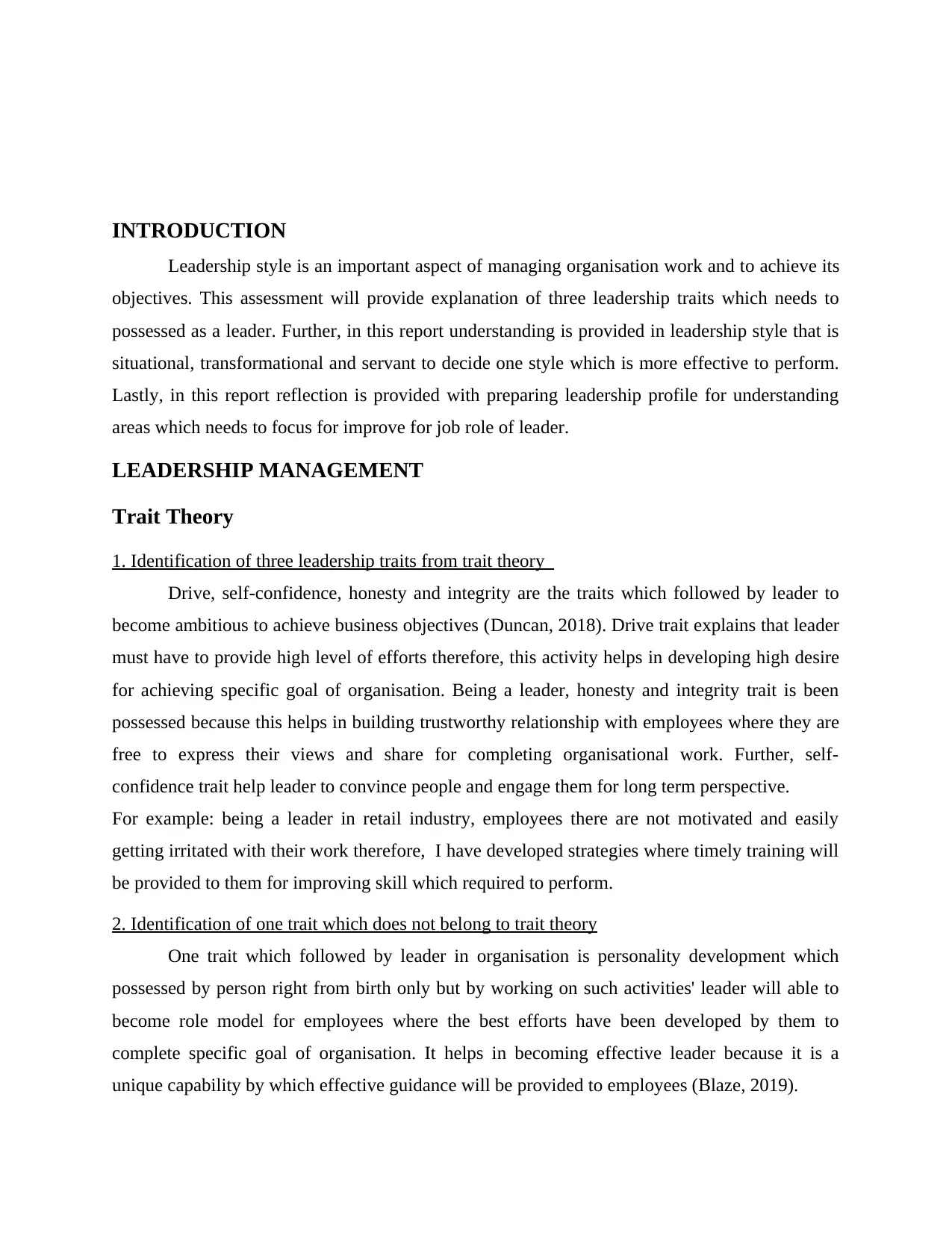
INTRODUCTION
Leadership style is an important aspect of managing organisation work and to achieve its
objectives. This assessment will provide explanation of three leadership traits which needs to
possessed as a leader. Further, in this report understanding is provided in leadership style that is
situational, transformational and servant to decide one style which is more effective to perform.
Lastly, in this report reflection is provided with preparing leadership profile for understanding
areas which needs to focus for improve for job role of leader.
LEADERSHIP MANAGEMENT
Trait Theory
1. Identification of three leadership traits from trait theory
Drive, self-confidence, honesty and integrity are the traits which followed by leader to
become ambitious to achieve business objectives (Duncan, 2018). Drive trait explains that leader
must have to provide high level of efforts therefore, this activity helps in developing high desire
for achieving specific goal of organisation. Being a leader, honesty and integrity trait is been
possessed because this helps in building trustworthy relationship with employees where they are
free to express their views and share for completing organisational work. Further, self-
confidence trait help leader to convince people and engage them for long term perspective.
For example: being a leader in retail industry, employees there are not motivated and easily
getting irritated with their work therefore, I have developed strategies where timely training will
be provided to them for improving skill which required to perform.
2. Identification of one trait which does not belong to trait theory
One trait which followed by leader in organisation is personality development which
possessed by person right from birth only but by working on such activities' leader will able to
become role model for employees where the best efforts have been developed by them to
complete specific goal of organisation. It helps in becoming effective leader because it is a
unique capability by which effective guidance will be provided to employees (Blaze, 2019).
Leadership style is an important aspect of managing organisation work and to achieve its
objectives. This assessment will provide explanation of three leadership traits which needs to
possessed as a leader. Further, in this report understanding is provided in leadership style that is
situational, transformational and servant to decide one style which is more effective to perform.
Lastly, in this report reflection is provided with preparing leadership profile for understanding
areas which needs to focus for improve for job role of leader.
LEADERSHIP MANAGEMENT
Trait Theory
1. Identification of three leadership traits from trait theory
Drive, self-confidence, honesty and integrity are the traits which followed by leader to
become ambitious to achieve business objectives (Duncan, 2018). Drive trait explains that leader
must have to provide high level of efforts therefore, this activity helps in developing high desire
for achieving specific goal of organisation. Being a leader, honesty and integrity trait is been
possessed because this helps in building trustworthy relationship with employees where they are
free to express their views and share for completing organisational work. Further, self-
confidence trait help leader to convince people and engage them for long term perspective.
For example: being a leader in retail industry, employees there are not motivated and easily
getting irritated with their work therefore, I have developed strategies where timely training will
be provided to them for improving skill which required to perform.
2. Identification of one trait which does not belong to trait theory
One trait which followed by leader in organisation is personality development which
possessed by person right from birth only but by working on such activities' leader will able to
become role model for employees where the best efforts have been developed by them to
complete specific goal of organisation. It helps in becoming effective leader because it is a
unique capability by which effective guidance will be provided to employees (Blaze, 2019).
⊘ This is a preview!⊘
Do you want full access?
Subscribe today to unlock all pages.

Trusted by 1+ million students worldwide
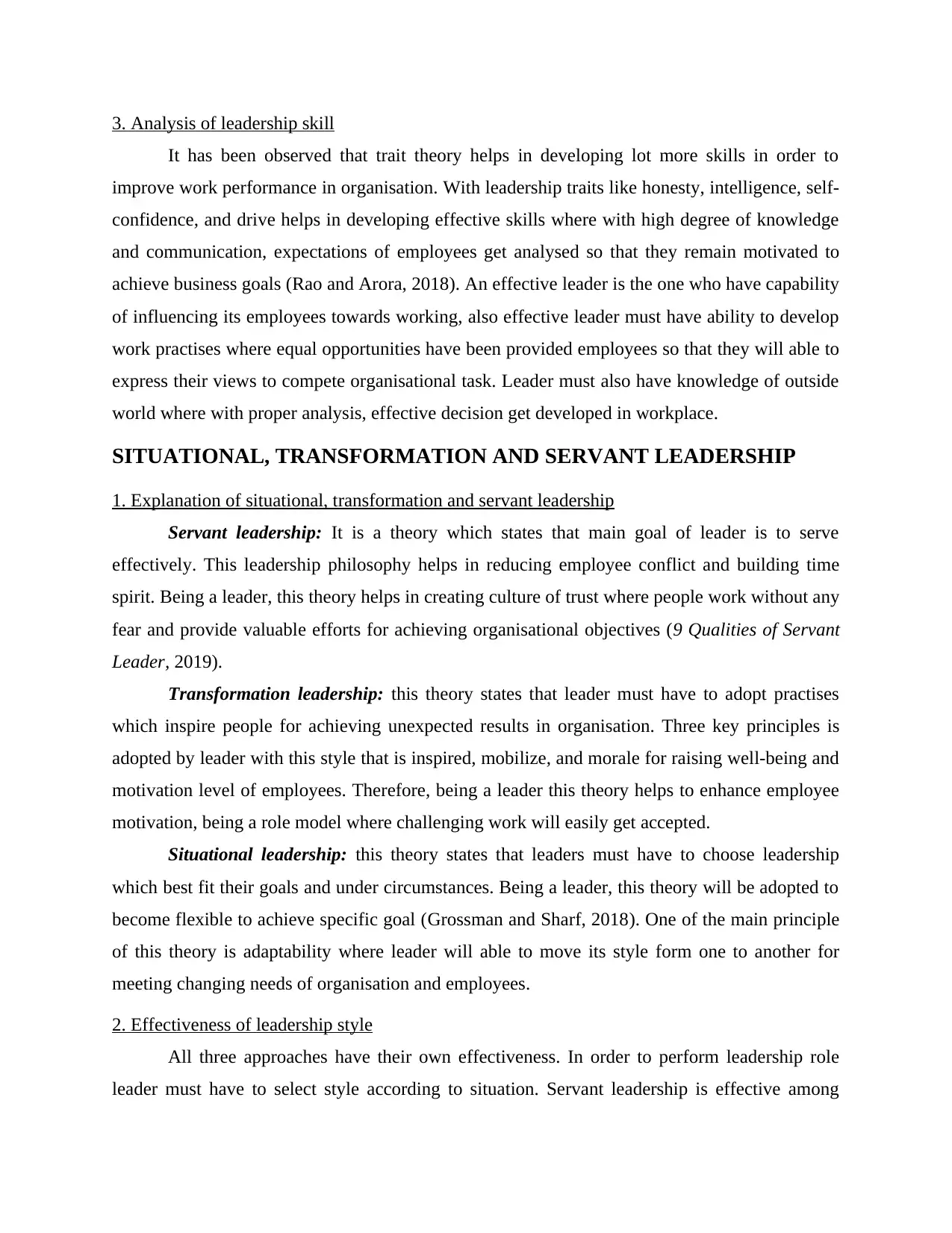
3. Analysis of leadership skill
It has been observed that trait theory helps in developing lot more skills in order to
improve work performance in organisation. With leadership traits like honesty, intelligence, self-
confidence, and drive helps in developing effective skills where with high degree of knowledge
and communication, expectations of employees get analysed so that they remain motivated to
achieve business goals (Rao and Arora, 2018). An effective leader is the one who have capability
of influencing its employees towards working, also effective leader must have ability to develop
work practises where equal opportunities have been provided employees so that they will able to
express their views to compete organisational task. Leader must also have knowledge of outside
world where with proper analysis, effective decision get developed in workplace.
SITUATIONAL, TRANSFORMATION AND SERVANT LEADERSHIP
1. Explanation of situational, transformation and servant leadership
Servant leadership: It is a theory which states that main goal of leader is to serve
effectively. This leadership philosophy helps in reducing employee conflict and building time
spirit. Being a leader, this theory helps in creating culture of trust where people work without any
fear and provide valuable efforts for achieving organisational objectives (9 Qualities of Servant
Leader, 2019).
Transformation leadership: this theory states that leader must have to adopt practises
which inspire people for achieving unexpected results in organisation. Three key principles is
adopted by leader with this style that is inspired, mobilize, and morale for raising well-being and
motivation level of employees. Therefore, being a leader this theory helps to enhance employee
motivation, being a role model where challenging work will easily get accepted.
Situational leadership: this theory states that leaders must have to choose leadership
which best fit their goals and under circumstances. Being a leader, this theory will be adopted to
become flexible to achieve specific goal (Grossman and Sharf, 2018). One of the main principle
of this theory is adaptability where leader will able to move its style form one to another for
meeting changing needs of organisation and employees.
2. Effectiveness of leadership style
All three approaches have their own effectiveness. In order to perform leadership role
leader must have to select style according to situation. Servant leadership is effective among
It has been observed that trait theory helps in developing lot more skills in order to
improve work performance in organisation. With leadership traits like honesty, intelligence, self-
confidence, and drive helps in developing effective skills where with high degree of knowledge
and communication, expectations of employees get analysed so that they remain motivated to
achieve business goals (Rao and Arora, 2018). An effective leader is the one who have capability
of influencing its employees towards working, also effective leader must have ability to develop
work practises where equal opportunities have been provided employees so that they will able to
express their views to compete organisational task. Leader must also have knowledge of outside
world where with proper analysis, effective decision get developed in workplace.
SITUATIONAL, TRANSFORMATION AND SERVANT LEADERSHIP
1. Explanation of situational, transformation and servant leadership
Servant leadership: It is a theory which states that main goal of leader is to serve
effectively. This leadership philosophy helps in reducing employee conflict and building time
spirit. Being a leader, this theory helps in creating culture of trust where people work without any
fear and provide valuable efforts for achieving organisational objectives (9 Qualities of Servant
Leader, 2019).
Transformation leadership: this theory states that leader must have to adopt practises
which inspire people for achieving unexpected results in organisation. Three key principles is
adopted by leader with this style that is inspired, mobilize, and morale for raising well-being and
motivation level of employees. Therefore, being a leader this theory helps to enhance employee
motivation, being a role model where challenging work will easily get accepted.
Situational leadership: this theory states that leaders must have to choose leadership
which best fit their goals and under circumstances. Being a leader, this theory will be adopted to
become flexible to achieve specific goal (Grossman and Sharf, 2018). One of the main principle
of this theory is adaptability where leader will able to move its style form one to another for
meeting changing needs of organisation and employees.
2. Effectiveness of leadership style
All three approaches have their own effectiveness. In order to perform leadership role
leader must have to select style according to situation. Servant leadership is effective among
Paraphrase This Document
Need a fresh take? Get an instant paraphrase of this document with our AI Paraphraser
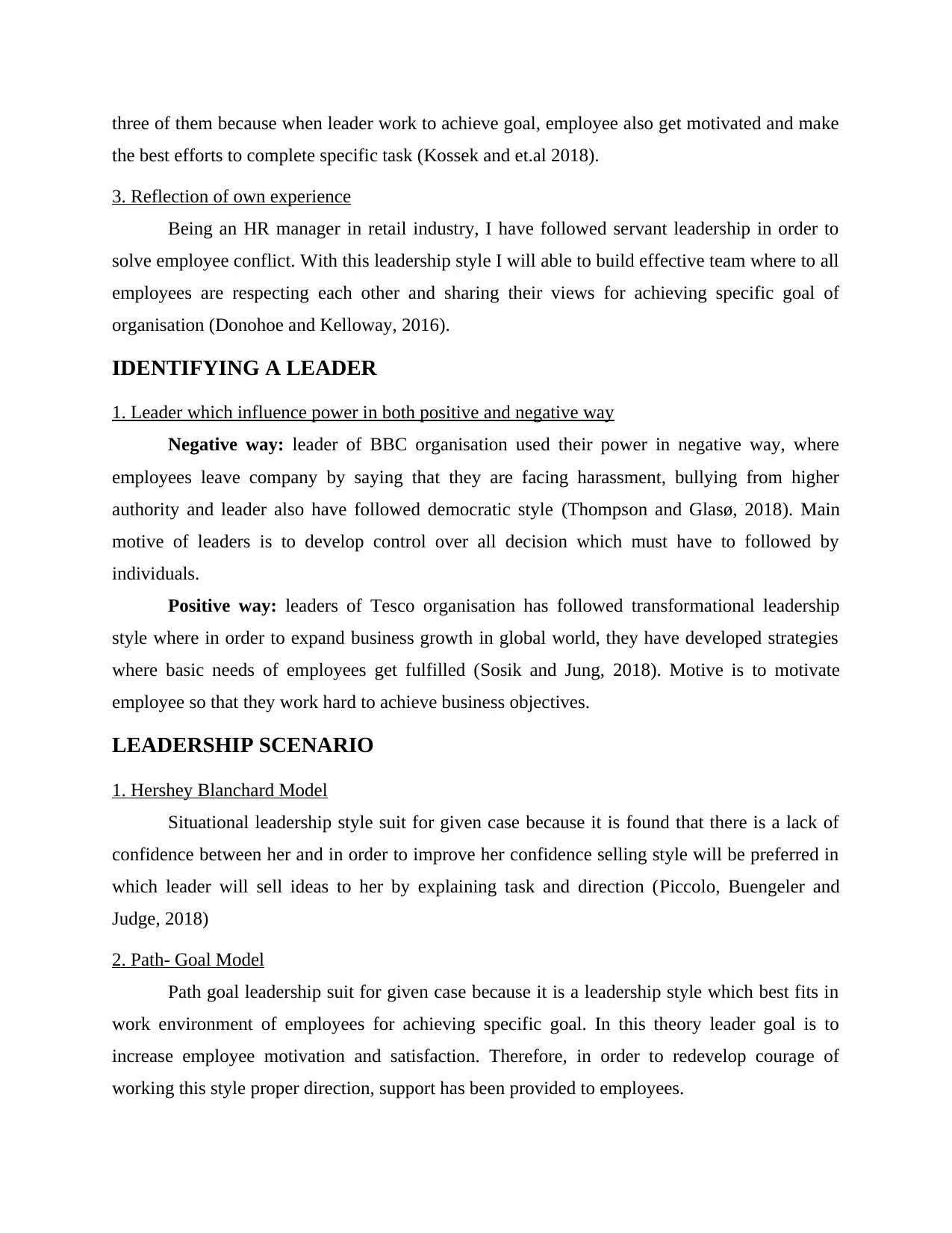
three of them because when leader work to achieve goal, employee also get motivated and make
the best efforts to complete specific task (Kossek and et.al 2018).
3. Reflection of own experience
Being an HR manager in retail industry, I have followed servant leadership in order to
solve employee conflict. With this leadership style I will able to build effective team where to all
employees are respecting each other and sharing their views for achieving specific goal of
organisation (Donohoe and Kelloway, 2016).
IDENTIFYING A LEADER
1. Leader which influence power in both positive and negative way
Negative way: leader of BBC organisation used their power in negative way, where
employees leave company by saying that they are facing harassment, bullying from higher
authority and leader also have followed democratic style (Thompson and Glasø, 2018). Main
motive of leaders is to develop control over all decision which must have to followed by
individuals.
Positive way: leaders of Tesco organisation has followed transformational leadership
style where in order to expand business growth in global world, they have developed strategies
where basic needs of employees get fulfilled (Sosik and Jung, 2018). Motive is to motivate
employee so that they work hard to achieve business objectives.
LEADERSHIP SCENARIO
1. Hershey Blanchard Model
Situational leadership style suit for given case because it is found that there is a lack of
confidence between her and in order to improve her confidence selling style will be preferred in
which leader will sell ideas to her by explaining task and direction (Piccolo, Buengeler and
Judge, 2018)
2. Path- Goal Model
Path goal leadership suit for given case because it is a leadership style which best fits in
work environment of employees for achieving specific goal. In this theory leader goal is to
increase employee motivation and satisfaction. Therefore, in order to redevelop courage of
working this style proper direction, support has been provided to employees.
the best efforts to complete specific task (Kossek and et.al 2018).
3. Reflection of own experience
Being an HR manager in retail industry, I have followed servant leadership in order to
solve employee conflict. With this leadership style I will able to build effective team where to all
employees are respecting each other and sharing their views for achieving specific goal of
organisation (Donohoe and Kelloway, 2016).
IDENTIFYING A LEADER
1. Leader which influence power in both positive and negative way
Negative way: leader of BBC organisation used their power in negative way, where
employees leave company by saying that they are facing harassment, bullying from higher
authority and leader also have followed democratic style (Thompson and Glasø, 2018). Main
motive of leaders is to develop control over all decision which must have to followed by
individuals.
Positive way: leaders of Tesco organisation has followed transformational leadership
style where in order to expand business growth in global world, they have developed strategies
where basic needs of employees get fulfilled (Sosik and Jung, 2018). Motive is to motivate
employee so that they work hard to achieve business objectives.
LEADERSHIP SCENARIO
1. Hershey Blanchard Model
Situational leadership style suit for given case because it is found that there is a lack of
confidence between her and in order to improve her confidence selling style will be preferred in
which leader will sell ideas to her by explaining task and direction (Piccolo, Buengeler and
Judge, 2018)
2. Path- Goal Model
Path goal leadership suit for given case because it is a leadership style which best fits in
work environment of employees for achieving specific goal. In this theory leader goal is to
increase employee motivation and satisfaction. Therefore, in order to redevelop courage of
working this style proper direction, support has been provided to employees.
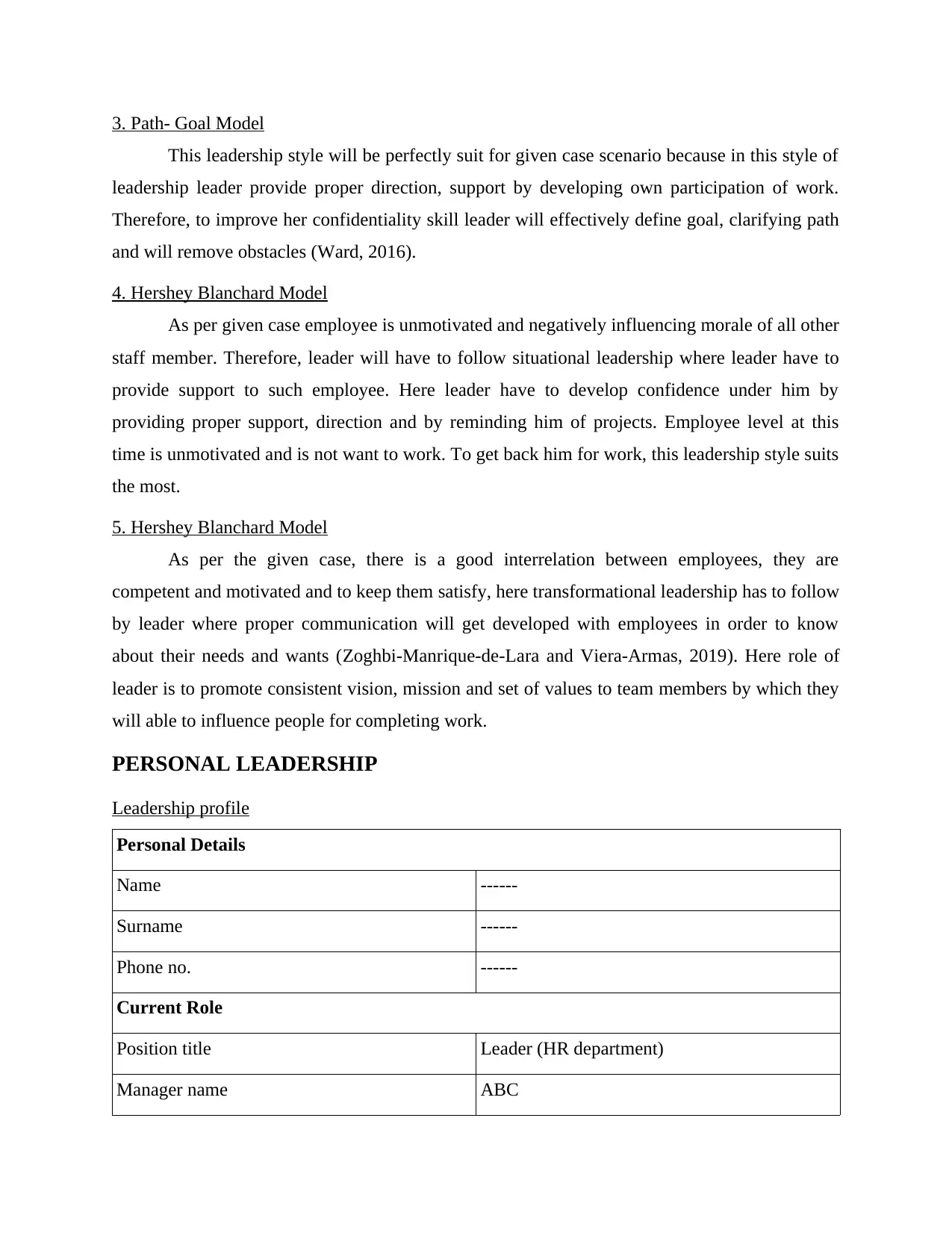
3. Path- Goal Model
This leadership style will be perfectly suit for given case scenario because in this style of
leadership leader provide proper direction, support by developing own participation of work.
Therefore, to improve her confidentiality skill leader will effectively define goal, clarifying path
and will remove obstacles (Ward, 2016).
4. Hershey Blanchard Model
As per given case employee is unmotivated and negatively influencing morale of all other
staff member. Therefore, leader will have to follow situational leadership where leader have to
provide support to such employee. Here leader have to develop confidence under him by
providing proper support, direction and by reminding him of projects. Employee level at this
time is unmotivated and is not want to work. To get back him for work, this leadership style suits
the most.
5. Hershey Blanchard Model
As per the given case, there is a good interrelation between employees, they are
competent and motivated and to keep them satisfy, here transformational leadership has to follow
by leader where proper communication will get developed with employees in order to know
about their needs and wants (Zoghbi-Manrique-de-Lara and Viera-Armas, 2019). Here role of
leader is to promote consistent vision, mission and set of values to team members by which they
will able to influence people for completing work.
PERSONAL LEADERSHIP
Leadership profile
Personal Details
Name ------
Surname ------
Phone no. ------
Current Role
Position title Leader (HR department)
Manager name ABC
This leadership style will be perfectly suit for given case scenario because in this style of
leadership leader provide proper direction, support by developing own participation of work.
Therefore, to improve her confidentiality skill leader will effectively define goal, clarifying path
and will remove obstacles (Ward, 2016).
4. Hershey Blanchard Model
As per given case employee is unmotivated and negatively influencing morale of all other
staff member. Therefore, leader will have to follow situational leadership where leader have to
provide support to such employee. Here leader have to develop confidence under him by
providing proper support, direction and by reminding him of projects. Employee level at this
time is unmotivated and is not want to work. To get back him for work, this leadership style suits
the most.
5. Hershey Blanchard Model
As per the given case, there is a good interrelation between employees, they are
competent and motivated and to keep them satisfy, here transformational leadership has to follow
by leader where proper communication will get developed with employees in order to know
about their needs and wants (Zoghbi-Manrique-de-Lara and Viera-Armas, 2019). Here role of
leader is to promote consistent vision, mission and set of values to team members by which they
will able to influence people for completing work.
PERSONAL LEADERSHIP
Leadership profile
Personal Details
Name ------
Surname ------
Phone no. ------
Current Role
Position title Leader (HR department)
Manager name ABC
⊘ This is a preview!⊘
Do you want full access?
Subscribe today to unlock all pages.

Trusted by 1+ million students worldwide
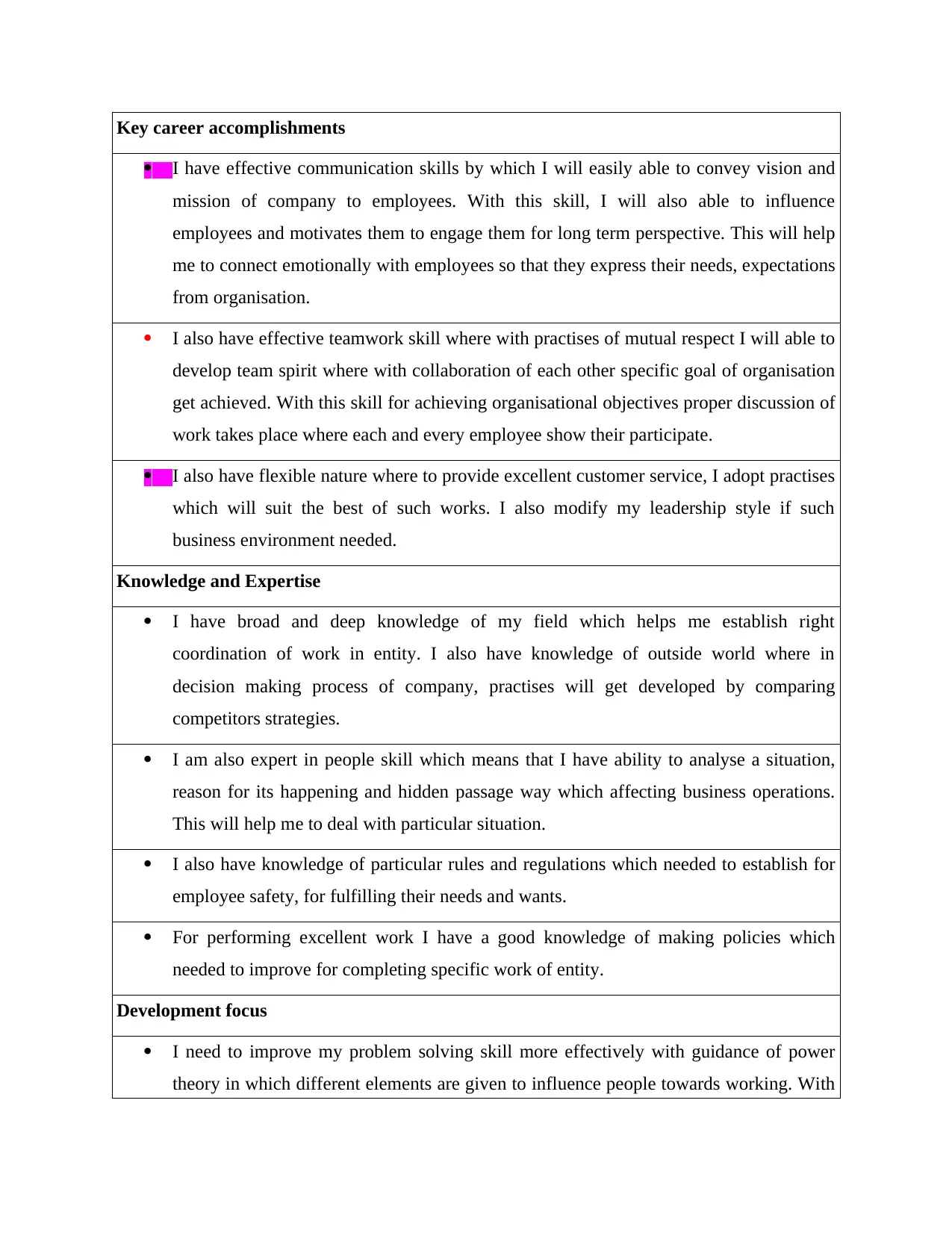
Key career accomplishments
I have effective communication skills by which I will easily able to convey vision and
mission of company to employees. With this skill, I will also able to influence
employees and motivates them to engage them for long term perspective. This will help
me to connect emotionally with employees so that they express their needs, expectations
from organisation.
I also have effective teamwork skill where with practises of mutual respect I will able to
develop team spirit where with collaboration of each other specific goal of organisation
get achieved. With this skill for achieving organisational objectives proper discussion of
work takes place where each and every employee show their participate.
I also have flexible nature where to provide excellent customer service, I adopt practises
which will suit the best of such works. I also modify my leadership style if such
business environment needed.
Knowledge and Expertise
I have broad and deep knowledge of my field which helps me establish right
coordination of work in entity. I also have knowledge of outside world where in
decision making process of company, practises will get developed by comparing
competitors strategies.
I am also expert in people skill which means that I have ability to analyse a situation,
reason for its happening and hidden passage way which affecting business operations.
This will help me to deal with particular situation.
I also have knowledge of particular rules and regulations which needed to establish for
employee safety, for fulfilling their needs and wants.
For performing excellent work I have a good knowledge of making policies which
needed to improve for completing specific work of entity.
Development focus
I need to improve my problem solving skill more effectively with guidance of power
theory in which different elements are given to influence people towards working. With
I have effective communication skills by which I will easily able to convey vision and
mission of company to employees. With this skill, I will also able to influence
employees and motivates them to engage them for long term perspective. This will help
me to connect emotionally with employees so that they express their needs, expectations
from organisation.
I also have effective teamwork skill where with practises of mutual respect I will able to
develop team spirit where with collaboration of each other specific goal of organisation
get achieved. With this skill for achieving organisational objectives proper discussion of
work takes place where each and every employee show their participate.
I also have flexible nature where to provide excellent customer service, I adopt practises
which will suit the best of such works. I also modify my leadership style if such
business environment needed.
Knowledge and Expertise
I have broad and deep knowledge of my field which helps me establish right
coordination of work in entity. I also have knowledge of outside world where in
decision making process of company, practises will get developed by comparing
competitors strategies.
I am also expert in people skill which means that I have ability to analyse a situation,
reason for its happening and hidden passage way which affecting business operations.
This will help me to deal with particular situation.
I also have knowledge of particular rules and regulations which needed to establish for
employee safety, for fulfilling their needs and wants.
For performing excellent work I have a good knowledge of making policies which
needed to improve for completing specific work of entity.
Development focus
I need to improve my problem solving skill more effectively with guidance of power
theory in which different elements are given to influence people towards working. With
Paraphrase This Document
Need a fresh take? Get an instant paraphrase of this document with our AI Paraphraser
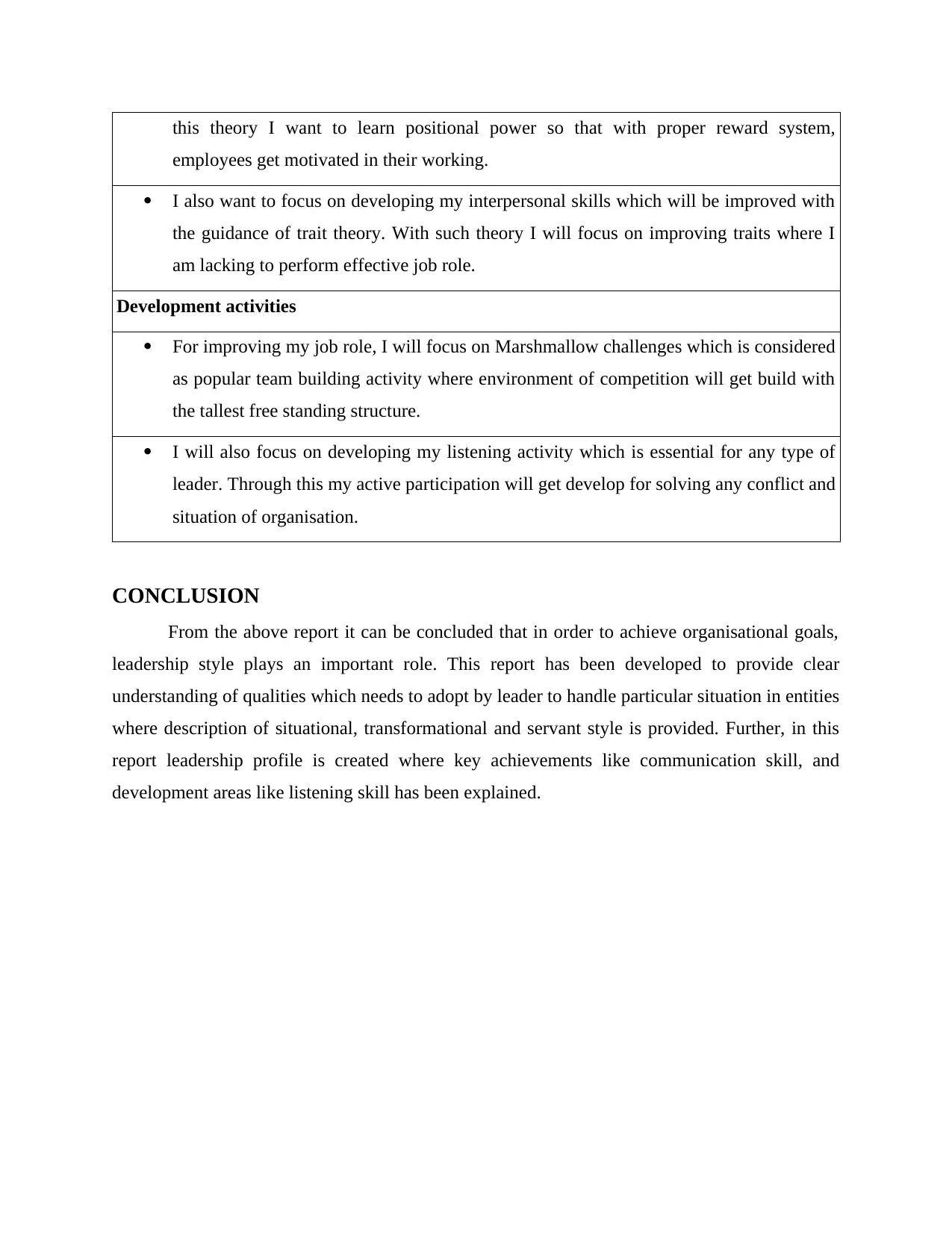
this theory I want to learn positional power so that with proper reward system,
employees get motivated in their working.
I also want to focus on developing my interpersonal skills which will be improved with
the guidance of trait theory. With such theory I will focus on improving traits where I
am lacking to perform effective job role.
Development activities
For improving my job role, I will focus on Marshmallow challenges which is considered
as popular team building activity where environment of competition will get build with
the tallest free standing structure.
I will also focus on developing my listening activity which is essential for any type of
leader. Through this my active participation will get develop for solving any conflict and
situation of organisation.
CONCLUSION
From the above report it can be concluded that in order to achieve organisational goals,
leadership style plays an important role. This report has been developed to provide clear
understanding of qualities which needs to adopt by leader to handle particular situation in entities
where description of situational, transformational and servant style is provided. Further, in this
report leadership profile is created where key achievements like communication skill, and
development areas like listening skill has been explained.
employees get motivated in their working.
I also want to focus on developing my interpersonal skills which will be improved with
the guidance of trait theory. With such theory I will focus on improving traits where I
am lacking to perform effective job role.
Development activities
For improving my job role, I will focus on Marshmallow challenges which is considered
as popular team building activity where environment of competition will get build with
the tallest free standing structure.
I will also focus on developing my listening activity which is essential for any type of
leader. Through this my active participation will get develop for solving any conflict and
situation of organisation.
CONCLUSION
From the above report it can be concluded that in order to achieve organisational goals,
leadership style plays an important role. This report has been developed to provide clear
understanding of qualities which needs to adopt by leader to handle particular situation in entities
where description of situational, transformational and servant style is provided. Further, in this
report leadership profile is created where key achievements like communication skill, and
development areas like listening skill has been explained.
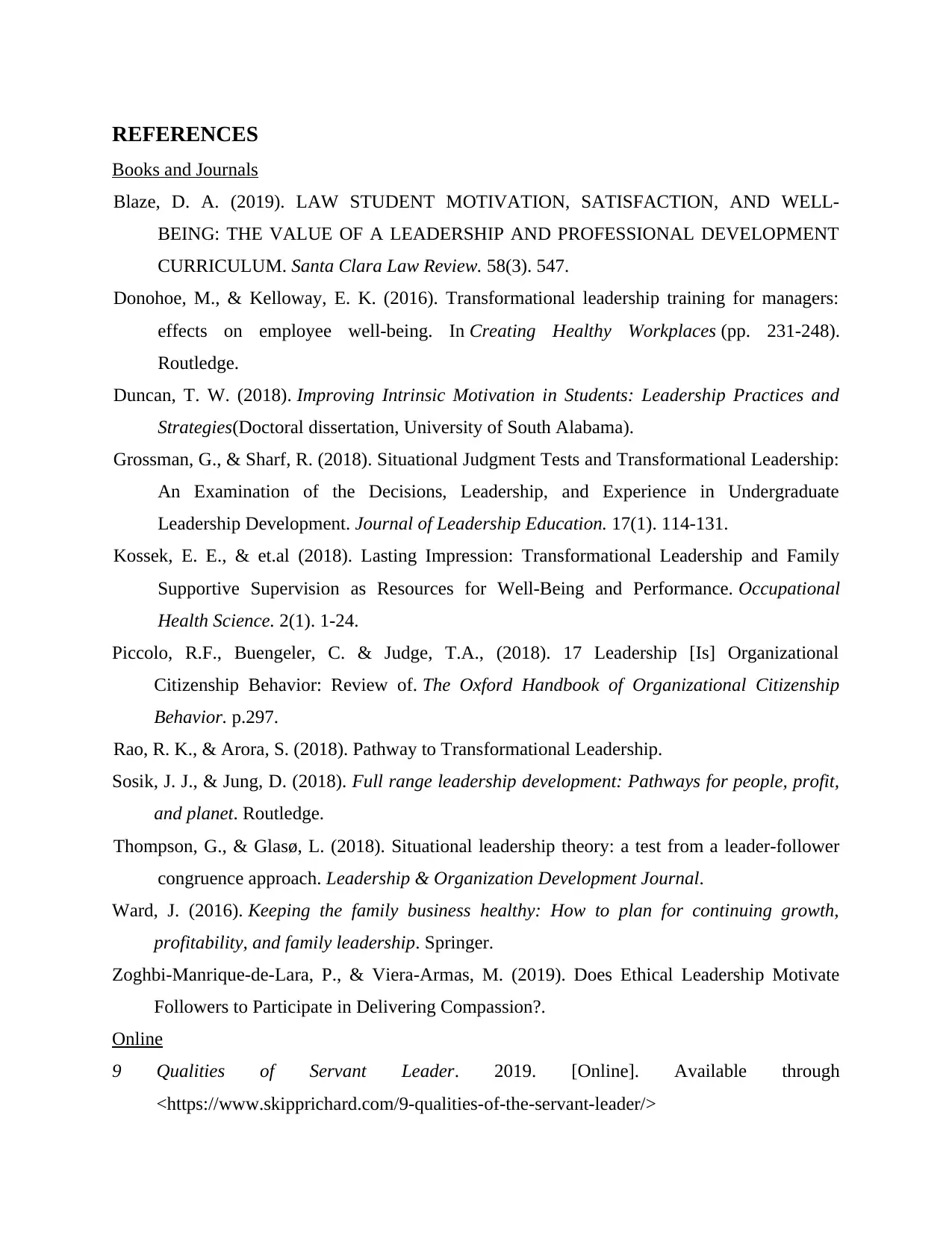
REFERENCES
Books and Journals
Blaze, D. A. (2019). LAW STUDENT MOTIVATION, SATISFACTION, AND WELL-
BEING: THE VALUE OF A LEADERSHIP AND PROFESSIONAL DEVELOPMENT
CURRICULUM. Santa Clara Law Review. 58(3). 547.
Donohoe, M., & Kelloway, E. K. (2016). Transformational leadership training for managers:
effects on employee well-being. In Creating Healthy Workplaces (pp. 231-248).
Routledge.
Duncan, T. W. (2018). Improving Intrinsic Motivation in Students: Leadership Practices and
Strategies(Doctoral dissertation, University of South Alabama).
Grossman, G., & Sharf, R. (2018). Situational Judgment Tests and Transformational Leadership:
An Examination of the Decisions, Leadership, and Experience in Undergraduate
Leadership Development. Journal of Leadership Education. 17(1). 114-131.
Kossek, E. E., & et.al (2018). Lasting Impression: Transformational Leadership and Family
Supportive Supervision as Resources for Well-Being and Performance. Occupational
Health Science. 2(1). 1-24.
Piccolo, R.F., Buengeler, C. & Judge, T.A., (2018). 17 Leadership [Is] Organizational
Citizenship Behavior: Review of. The Oxford Handbook of Organizational Citizenship
Behavior. p.297.
Rao, R. K., & Arora, S. (2018). Pathway to Transformational Leadership.
Sosik, J. J., & Jung, D. (2018). Full range leadership development: Pathways for people, profit,
and planet. Routledge.
Thompson, G., & Glasø, L. (2018). Situational leadership theory: a test from a leader-follower
congruence approach. Leadership & Organization Development Journal.
Ward, J. (2016). Keeping the family business healthy: How to plan for continuing growth,
profitability, and family leadership. Springer.
Zoghbi-Manrique-de-Lara, P., & Viera-Armas, M. (2019). Does Ethical Leadership Motivate
Followers to Participate in Delivering Compassion?.
Online
9 Qualities of Servant Leader. 2019. [Online]. Available through
<https://www.skipprichard.com/9-qualities-of-the-servant-leader/>
Books and Journals
Blaze, D. A. (2019). LAW STUDENT MOTIVATION, SATISFACTION, AND WELL-
BEING: THE VALUE OF A LEADERSHIP AND PROFESSIONAL DEVELOPMENT
CURRICULUM. Santa Clara Law Review. 58(3). 547.
Donohoe, M., & Kelloway, E. K. (2016). Transformational leadership training for managers:
effects on employee well-being. In Creating Healthy Workplaces (pp. 231-248).
Routledge.
Duncan, T. W. (2018). Improving Intrinsic Motivation in Students: Leadership Practices and
Strategies(Doctoral dissertation, University of South Alabama).
Grossman, G., & Sharf, R. (2018). Situational Judgment Tests and Transformational Leadership:
An Examination of the Decisions, Leadership, and Experience in Undergraduate
Leadership Development. Journal of Leadership Education. 17(1). 114-131.
Kossek, E. E., & et.al (2018). Lasting Impression: Transformational Leadership and Family
Supportive Supervision as Resources for Well-Being and Performance. Occupational
Health Science. 2(1). 1-24.
Piccolo, R.F., Buengeler, C. & Judge, T.A., (2018). 17 Leadership [Is] Organizational
Citizenship Behavior: Review of. The Oxford Handbook of Organizational Citizenship
Behavior. p.297.
Rao, R. K., & Arora, S. (2018). Pathway to Transformational Leadership.
Sosik, J. J., & Jung, D. (2018). Full range leadership development: Pathways for people, profit,
and planet. Routledge.
Thompson, G., & Glasø, L. (2018). Situational leadership theory: a test from a leader-follower
congruence approach. Leadership & Organization Development Journal.
Ward, J. (2016). Keeping the family business healthy: How to plan for continuing growth,
profitability, and family leadership. Springer.
Zoghbi-Manrique-de-Lara, P., & Viera-Armas, M. (2019). Does Ethical Leadership Motivate
Followers to Participate in Delivering Compassion?.
Online
9 Qualities of Servant Leader. 2019. [Online]. Available through
<https://www.skipprichard.com/9-qualities-of-the-servant-leader/>
⊘ This is a preview!⊘
Do you want full access?
Subscribe today to unlock all pages.

Trusted by 1+ million students worldwide
1 out of 9
Related Documents
Your All-in-One AI-Powered Toolkit for Academic Success.
+13062052269
info@desklib.com
Available 24*7 on WhatsApp / Email
![[object Object]](/_next/static/media/star-bottom.7253800d.svg)
Unlock your academic potential
Copyright © 2020–2025 A2Z Services. All Rights Reserved. Developed and managed by ZUCOL.





